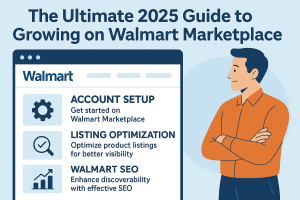Amazon may dominate e-commerce, but Walmart Marketplace has quietly become one of the most profitable alternatives for online sellers. With lower competition, fewer saturated categories, and over 120 million monthly visitors in the U.S. alone, Walmart is now the platform ambitious brands cannot afford to ignore.
The tool that makes it all possible is Seller Central Walmart — the hub where you manage listings, track performance, and scale your business. If you’re serious about hitting six- or seven-figure sales on Walmart, you must master this platform.
This 2025 guide dives deep into Walmart’s Seller Central: from setting up your account to optimizing listings, running ads, using Walmart Fulfillment Services (WFS), and building a long-term growth strategy.
What is Seller Central Walmart?
Walmart Seller Central is the control panel where third-party sellers manage their business on Walmart Marketplace. Similar to Amazon Seller Central, it gives you access to tools for:
- Product listings and optimization
- Order and return management
- Advertising campaigns
- Pricing, inventory, and fulfillment settings
- Performance metrics and compliance
Think of it as the “mission control” for your Walmart business. Mastering the dashboard is the first step toward sustainable sales growth.
Why Sell on Walmart in 2025?
Before we dive into the technicals of Seller Central Walmart, let’s understand why Walmart is worth your attention:
- Massive Traffic: Walmart.com attracts over 120 million monthly unique visitors in the U.S. (Statista, 2024).
- Lower Competition: With fewer sellers compared to Amazon, Walmart listings have more visibility.
- Trust Factor: Walmart’s brand recognition builds immediate credibility with shoppers.
- Walmart Fulfillment Services (WFS): Direct competitor to Amazon FBA, offering 2-day shipping across the U.S.
- Multi-channel Potential: Walmart integrates with Google Shopping, social media ads, and even in-store pickups.
For brands already selling on Amazon, adding Walmart can create a powerful multi-channel revenue stream.
Step 1: How to Set Up Your Walmart Seller Central Account
Getting approved on Walmart Marketplace is stricter than Amazon, but that exclusivity also reduces low-quality competition. Here’s how to apply:
Application Requirements
- U.S. Business Tax ID (SSN not accepted)
- W-9 or W-8 and EIN verification letter from the IRS
- U.S. business address
- History of marketplace or e-commerce success
- Bank account information
Application Process
- Visit Walmart Marketplace Application.
- Submit business and tax details.
- Wait for approval (usually 1–2 weeks).
- Once approved, log into Seller Central Walmart.
Tip: Walmart prefers experienced sellers. Highlight your track record (e.g., Amazon, Shopify) during application.

Step 2: Navigating the Walmart Seller Central Dashboard
The dashboard may feel overwhelming at first. Here’s a breakdown of the key sections:
- Items & Listings: Add, edit, and optimize product listings.
- Orders: Track shipments, cancellations, and returns.
- Analytics: Monitor sales performance, impressions, and conversion rates.
- Growth Opportunities: Walmart provides insights on trending categories and underpriced products.
- Advertising: Run Sponsored Products or Walmart Connect ads.
- Settings: Tax, shipping templates, payment setup.
Step 3: Creating Optimized Product Listings
Just like Amazon, Walmart uses its own search algorithm (called the Walmart Relevance Algorithm). To rank well, follow these listing best practices:
Title Optimization
Include primary keywords, brand name, and essential attributes. Example:
“Organic Vitamin C Gummies – 120 Count, Non-GMO, Immune Support”
Bullet Points & Description
- Focus on benefits, not just features.
- Use formatting for scannability.
- Answer common buyer questions.
Images & Rich Media
- At least 4–6 high-resolution images.
- Lifestyle photos to build trust.
- Infographics with benefits and features.
Backend Keywords
Walmart allows “Shelf Descriptions” and “Attributes.” Use them wisely with keywords and synonyms.
Step 4: Pricing Strategy for Walmart Success
Walmart’s algorithm heavily favors the Buy Box winner. To win it, you must:
- Offer competitive prices (Amazon matching helps).
- Maintain strong seller performance metrics.
- Use repricing tools for automation.
Unlike Amazon, Walmart penalizes artificially inflated prices compared to other marketplaces. Always keep your listings consistent.
Step 5: Fulfillment Options (WFS vs. Self-Fulfillment)
Walmart Fulfillment Services (WFS)
- Similar to Amazon FBA.
- 2-day nationwide delivery.
- Improved Buy Box eligibility.
- Handles storage, shipping, and returns.
Self-Fulfillment
- More control but harder to scale.
- You must meet Walmart’s strict on-time delivery standards.
Prolific Zone Tip: For scaling to six figures, WFS is the most effective option.
Step 6: Advertising with Walmart Connect
Walmart advertising is still underused compared to Amazon PPC, meaning lower CPC (cost-per-click). Inside Seller Central Walmart, you can launch:
- Sponsored Products – Show up in search results and product detail pages.
- Sponsored Brands – Boost brand visibility with banner ads.
- Display Ads – Retarget buyers across Walmart’s ecosystem.
Start small, collect data, and gradually scale with high-ROI campaigns.
Step 7: Monitoring Performance Metrics
Walmart requires sellers to maintain strict performance standards:
- On-Time Shipment Rate: ≥ 99%
- Order Cancellation Rate: ≤ 2%
- Order Defect Rate: ≤ 2%
Failure to meet these can lead to account suspension. Use Walmart’s Analytics Dashboard inside Seller Central to monitor KPIs weekly.

Step 8: Scaling Your Walmart Business
Once your listings are optimized and sales are steady, it’s time to scale:
- Expand Product Catalog: Launch related SKUs.
- International Expansion: Walmart Canada and Mexico are growing markets.
- Leverage External Traffic: Drive traffic via Google Ads, TikTok, and Facebook.
- Automate Operations: Use agencies like Prolific Zone to manage PPC, SEO, and account health.
Common Mistakes to Avoid on Walmart Seller Central
- Copy-pasting Amazon listings without optimization.
- Failing to meet Walmart’s stricter approval requirements.
- Ignoring pricing consistency across platforms.
- Underestimating the power of WFS.
Conclusion: Why Seller Central Walmart is a Goldmine in 2025
Seller Central Walmart is more than just a dashboard — it’s the gateway to one of the fastest-growing e-commerce platforms in the U.S. While competition is fierce on Amazon, Walmart gives you a chance to dominate categories with less saturation, higher visibility, and strong margins.
By mastering account setup, listing optimization, WFS, advertising, and performance monitoring, you can scale your Walmart store into a six-figure business in record time.
Ready to grow? At Prolific Zone, we help brands thrive on Walmart, Amazon, and beyond. Contact us today to maximize your Walmart Seller Central potential.
